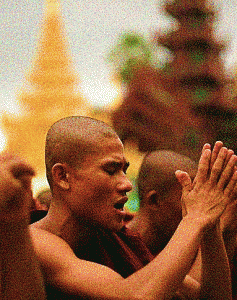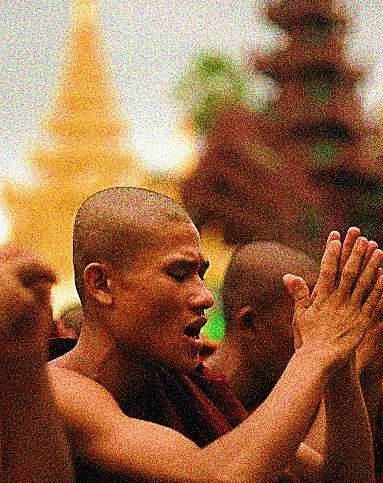 For the past year, Myanmar’s Rakhine State has been overwhelmed by rampant sectarian violence between Buddhists and Muslims. Besides fighting each other, the two communities are also battling global media outlets and the Burmese government for control over the world’s perception of the violence that is permeating their own lives.
For the past year, Myanmar’s Rakhine State has been overwhelmed by rampant sectarian violence between Buddhists and Muslims. Besides fighting each other, the two communities are also battling global media outlets and the Burmese government for control over the world’s perception of the violence that is permeating their own lives.
Time magazine’s July 1 issue has been one of the most controversial attempts at framing the violence. The cover condemns Buddhist monk U Wirathu, leader of the Buddhist nationalist 969 Movement, as the “face of Buddhist terror.” In reaction, Myanmar President Thein Sein promptly banned the issue for allegedly misrepresenting Myanmar’s Buddhists and the situation in Rakhine. A closer examination of the Rakhine state violence reveals that the issue is much more complex than both Time and the nation’s president make it out to be.
The recent clashes between Rakhine Buddhists and Rohingya Muslims began in June 2012 with the rape and murder of a Buddhist woman by three Rohingya attackers, which initiated a violent backlash from members of the Buddhist community. Since then, around 250 people in the Rakhine region have been killed and several thousand, mostly Muslims, have been forced to flee their homes. Everyone agrees that the conflict is horrific—President Sein issued a state of emergency in the region back in March. But what remains contested is who should be held responsible for the violence. Who is really attacking whom?
Many, including Time, are pointing straight at U Wirathu, whose anti-Islamic 969 campaign has hit city streets with posters, CDs, and graffiti to advertise its disturbing platform. Wirathu dreams of a religiously segregated Myanmar and has drafted a law that restricts inter-faith marriage. Only 5 percent of the Burmese population identifies as Muslim, and yet the 969 campaign views this narrow demographic as a burden and threat to Burmese Buddhists. Wirathu’s following of Buddhist monks is growing, and his sermons seem to be inspiring hate and violence, despite the campaign’s claim to have non-violent intentions.
Other groups in Myanmar, like this purportedly Muslim Facebook group, insist it is not the Buddhists who are causing violence. However, the emerging correlation between the campaign’s increasing size and influence and an increase in anti-Muslim riots is difficult to deny. One Muslim resident expressed his fears, saying “the more we see the ‘969’ signs, the more we feel unsafe.” From the other side, Wirathu expresses concerns for his own safety. In an interview with the Irrawaddy, he claimed that Muslims “want me to be arrested, or killed. That’s why they put me on the [Time] cover, I think. … Extremists are trying to turn Burma into an Islamic country.”
In the midst of this blame game, President Thein Sein refuses to publicly choose sides. When questioned by ABC News, Sein denied that the violence in Rakhine is at all ethnic, racial, or religious, claiming that the portrayal of the violence as such only polarizes the communities further. He has also defended the campaign, calling U Wirathu “noble,” which exposes the government’s bias and excuses the hate-speech that, if not directly inspiring violence, undoubtedly encourages the further bifurcation of communities.
So far Sein’s tactic of forcibly denying the ethno-religious charge has not made situation easier to resolve. Order has not been restored to the region and hopes of reconciliation between groups recede as the violence increases. If Sein continues to support a campaign that preaches hate, he will effectively obliterate the nation’s chances of restoring peace and creating unity among its diverse peoples. We can only hope that the growing urgency of the situation will force the Burmese government to drop the act and start promoting tolerance and integration now, both for the sake of those suffering in the Rakhine state, and for the nation’s future as a transitioning democracy.
Emma Lo is an intern at Foreign Policy in Focus.

